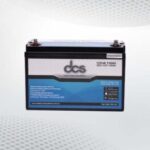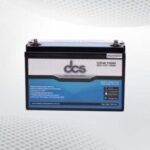When it comes to powering your projects, the right choice of battery can make all the difference. Whether it’s for renewable energy storage, backup power, or mobile applications, the 12v 200ah battery stands out as a robust and reliable option. Its unique combination of voltage and capacity makes it perfectly suited for a wide range of needs, providing a dependable power source that can help bring your projects to life.
Understanding the Basics of a 12V 200-ah Battery
A 12v 200-ah battery is distinguished by its capability to store and deliver electrical energy at a consistent voltage of 12 volts with an impressive storage capacity of 200 ampere-hours (Ah). This configuration denotes that, under optimal conditions, it has the potential to output a current of 200 amperes over the span of one hour or alternatively, provide a lower current of 10 amperes over an extended period of 20 hours.
Its design, primarily focused on reusability, allows for multiple charge and discharge cycles, making it a dynamic and sustainable choice for various applications. The composition and structure of these batteries enable them to be recharged after each use, promoting longevity and efficiency in energy utilisation.
The 12V 200-Ah specification not only reflects the battery’s voltage and capacity but also signifies its suitability for tasks demanding substantial energy over prolonged periods. This makes it an invaluable resource in settings where reliability and endurance are paramount. Understanding these fundamental characteristics is crucial for anyone looking to harness the full potential of a 12v 200-ah battery in their respective projects or applications.
The Benefits of Opting for a 12-volt 200Ah Battery
Choosing a 12-volt 200Ah battery comes with a plethora of advantages that significantly enhance the performance and reliability of various projects and applications. One of the foremost benefits is the exceptional balance between compactness and energy storage capability this battery type offers.
Its ability to house a considerable energy reserve within a relatively modest footprint makes it a prime choice for scenarios where space efficiency and weight considerations play crucial roles. These batteries excel in delivering sustained, reliable power, making them indispensable in both routine and critical applications.
Another distinct advantage lies in their longevity and superior cycle stability. Compared to counterparts with similar power capacities, 12-volt 200Ah batteries generally exhibit a longer service life and enhanced resilience to frequent charging and discharging cycles. This aspect not only ensures a more dependable power source over time but also contributes to cost savings by reducing the need for frequent replacements.
Their deep-cycle design is particularly advantageous, facilitating consistent power output until complete discharge. This characteristic is vital in applications requiring an uninterrupted energy supply over extended periods, ensuring operational reliability and efficiency. Furthermore, their robust construction enables these batteries to endure diverse environmental conditions, enhancing their versatility across a broad spectrum of uses, from remote off-grid setups to demanding marine environments. By embracing the 12-volt 200Ah battery, users gain access to a high-performing, durable, and adaptable energy solution.
The Versatility of 12V 200Ah Batteries in Various Applications
The 12v 200ah battery’s adaptability spans an impressive array of applications, making it a cornerstone in both everyday and specialised equipment. Its substantial energy reserve is ideal for powering recreational vehicles and caravans, providing the freedom to explore without compromising on power.
In the realm of renewable energy, these batteries are pivotal in solar installations, serving as essential components for storing excess power generated during peak sunlight hours. Their robustness also lends them perfectly to marine applications, where they fuel navigation systems, onboard amenities, and safety equipment, even in the most challenging sea conditions.
Emergency power systems, too, benefit from the reliability of the 12v 200-ah battery, offering critical support during power outages to keep essential services running smoothly. Moreover, their durability and consistent performance under various temperature ranges make them invaluable in remote communication towers and monitoring stations, where dependable energy sources are non-negotiable.
This versatility not only highlights the broad utility of 12v 200-ah batteries across different sectors but also underscores their role in enhancing efficiency and reliability, irrespective of the application domain.
Tips for Maximising the Lifespan of Your 12V 200-ah Battery
To optimise the longevity of your 12V 200-ah battery, a comprehensive approach to maintenance is essential. Firstly, it’s advisable to maintain a regular charging schedule to prevent the battery from remaining in a discharged state for extended periods. This practice helps in keeping the battery’s internal chemistry in optimal condition. Avoid allowing the battery to undergo deep discharges regularly; instead, aim to keep the charge level above 50% as much as possible.
Temperature plays a crucial role in the health of your battery. Extreme cold can reduce its efficiency, while excessive heat can lead to accelerated degradation of its components. Strive to store and operate the battery within a moderate temperature range to safeguard its longevity.
The use of a compatible charger cannot be overstated. Invest in a charger that matches the battery’s specifications and features mechanisms to prevent overcharging. Chargers that automatically switch to a maintenance or trickle mode once the battery is fully charged are ideal, as they help in maintaining the battery at its peak without causing damage.
Periodic checks and cleaning of the battery terminals to remove any corrosion build-up ensure a good connection and efficient power delivery. Also, inspecting the battery case for signs of wear or damage can preempt potential issues.
By adhering to these maintenance tips, you can significantly extend the service life of your 12V 200-ah battery, ensuring it remains a reliable power source for your needs.
How to Choose the Right 12V 200-Ah Battery for Your Needs
Selecting the ideal 12V 200-Ah battery necessitates a thorough evaluation of your specific requirements and the conditions under which the battery will operate. Begin by assessing the application’s energy demand. For high-energy applications, ensure the battery’s ampere-hour (Ah) rating sufficiently meets your project’s continuous and peak energy usage.
Next, examine the physical constraints of your setup. The dimensions and weight of the battery should align with the available space and the structural capacity of your installation. Additionally, the terminal type of the battery is critical for ensuring a secure and efficient connection to your system.
Another vital consideration is the battery technology. Different technologies such as Absorbed Glass Mat (AGM), lead-acid, or lithium-ion offer varying advantages in terms of efficiency, maintenance requirements, and operational lifespan. For instance, AGM batteries are well-suited for applications requiring high discharge and recharge efficiency, whereas lithium-ion batteries, although more expensive, provide a longer lifespan and better performance in a wider range of temperatures.
The operational environment of the battery is also a key factor. Evaluate whether the battery will be exposed to extreme temperatures, moisture, or other environmental stresses, and choose a battery designed to withstand these conditions.
Finally, consider the manufacturer’s reputation and the warranty provided. Opt for brands known for their reliability and customer support to ensure you receive a quality product that is supported throughout its lifespan.
Understanding the Environmental Impact of 12V 200-Ah Batteries
Acknowledging the environmental ramifications of using 12V 200-Ah batteries is paramount for fostering a sustainable approach towards energy storage. Primarily constructed from lead-acid or lithium-ion, these batteries pose different degrees of environmental challenges.
Lead-acid batteries, whilst cost-effective and widely used, contain toxic substances such as lead and sulphuric acid, which necessitate stringent recycling protocols to mitigate soil and water contamination risks. The recycling process is vital in preventing hazardous materials from entering the ecosystem, thereby reducing the potential for environmental damage.
On the other hand, lithium-ion batteries, despite being more eco-friendly in comparison, also demand responsible disposal and recycling measures. These batteries contain valuable materials that can be recovered and reused, thus contributing to a circular economy and diminishing the demand for raw materials extraction. However, improper disposal can lead to the release of toxic substances, underscoring the importance of established recycling schemes.
The environmental impact extends beyond disposal concerns, encompassing the energy consumed during manufacturing processes. Efforts are ongoing to enhance the energy efficiency of production and increase the use of renewable energy sources, aiming to lower the overall carbon footprint associated with these batteries.
As awareness grows, manufacturers and consumers alike are encouraged to adopt greener practices, including the integration of more sustainable materials and the support of comprehensive recycling programmes. Such initiatives are crucial for ensuring that the advantages of 12V 200-Ah batteries are harnessed in a manner that aligns with environmental stewardship and sustainability goals.
The Future of 12V 200-Ah Batteries in Energy Systems
The trajectory of 12V 200-Ah batteries within energy systems is poised for remarkable evolution, underpinned by cutting-edge innovations and an increasing emphasis on sustainability. Research and development efforts are continuously refining the efficiency, resilience, and ecological footprint of these batteries. Emerging materials and enhanced manufacturing techniques promise to extend their lifespan further and reduce the environmental impact of their production and disposal.
In the realm of renewable energy, the role of 12V 200-Ah batteries is expanding. Their capacity to store energy more efficiently makes them pivotal in bridging the gap between energy generation and usage peaks, thereby facilitating a smoother transition to renewable sources. Additionally, the push towards electrification of transport systems foresees a significant role for these batteries, not just in electric vehicles but also in supporting infrastructure such as charging stations and grid services.
Moreover, the integration of smart technology with 12V 200-Ah battery systems is on the horizon. This fusion aims to optimise energy storage and distribution, enabling more precise control over how energy is consumed and saved. Such advancements are expected to enhance the adaptability of these batteries to varying energy demands and conditions, underscoring their potential to be at the heart of future smart grids and renewable energy systems.
As the landscape of energy storage shifts towards more innovative and sustainable solutions, 12V 200-Ah batteries are at the forefront, heralding a new era in the efficiency and flexibility of power systems.
 FAQs
FAQs
Is it feasible for a 12V 200-Ah battery to power a household?
The ability to power a home entirely depends on the household’s energy usage. A single 12V 200-Ah battery yields approximately 2.4kWh, which may be sufficient for essential devices during power outages or contribute as part of a broader energy storage setup.
What is the expected lifespan of a 12V 200-Ah battery?
The longevity of these batteries is dependent on the type of technology they’re based on, their operational handling, and maintenance practices. Typically, lead-acid versions last between 4 to 7 years, whereas lithium-ion variants can last up to 10 to 15 years, reflecting a considerable variance in durability.
Can a 12V 200-Ah battery be utilised for solar energy storage?
Indeed, these batteries are suitable for solar energy storage applications, particularly beneficial in off-grid setups or as backup power solutions. Their ample storage capacity makes them ideal for accumulating solar energy throughout the day for nighttime utilisation.
How safe are 12V 200-Ah batteries?
With proper use and maintenance, these batteries pose minimal safety risks. It’s imperative to adhere to safety guidelines to avoid potential hazards such as short circuits or overcharging, ensuring safe operation across various applications.
Conclusion
The utility of the 12V 200Ah battery across diverse domains is unmistakable, offering both individuals and industries a dependable source of power. Its capacity to serve various needs, from renewable energy storage to providing emergency backup, underscores its significance. The key to unlocking its full potential lies in a comprehensive understanding of its characteristics, coupled with meticulous care and maintenance.
| Other Good Articles to Read |
| Blogs Rain |
| Cme Blog Spot |
| Garcias Blogs |
| Yyc Blogs |
| Blogs-Hunt |
| Impact-Blog |
| Smarty Blogs |
| Ed Blog |
| Mo Blogs |
| Blogs Em |
| Blogs T |
| Related Business Listings |
| Directory Submissions |
| Regional Directory |



